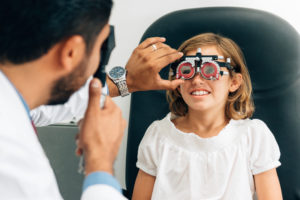July 1, 2021
By Erin Lam, BVisSci, MOptom, Research Optometrist, Brien Holden Vision Institute

The rising prevalence of myopia and high myopia is an area of significant interest to the eye care professional. The ability to identify at-risk children through percentile curves would be highly beneficial as this would provide clinicians with an opportunity to apply preventative measures to minimize axial length (AL) elongation and thus, curb the rise of myopia and high myopia.
The aim of Tideman et al. 2018 was to generate a percentile curve for AL and to determine the associated risk of developing myopia in European children by combining data from three large population-based studies of European children and adults: The Generation R Study, the Avon Longitudinal Study of Parents and Children, and the Rotterdam Study III. The three studies totaled 12,386 participants, including Dutch children aged 6 and 9 years old, British children aged 15 years, and Dutch adults over 45 years old (mean age of 57). Data extracted from the studies included AL, corneal curvature, and objective cycloplegic refractive error (only Dutch participants). A percentile score was calculated for each Dutch child at 6 and 9 years of age. While all percentiles examined increased in AL (average 0.21mm/year), none of the percentiles below the median increased further after the age of 15. The myopic children had more rapid eye growth (0.31mm/year) as compared to the emmetropic (0.19mm/year) and hyperopic children (0.15mm/year). The above-median percentiles of AL indicated a >50% risk of developing myopia in adulthood, while the highest 10th percentile indicated a 97% risk of myopia and 23% risk of high myopia. Additionally, a significant change in percentile position between the ages of 6 and 9 was strongly correlated to myopia prevalence.
This study was the first to generate a percentile curve for AL in European children. Its strengths lie in the large data sample and the specific age categories, both of which allowed for robust analysis. However, it lacks a study population between the ages of 20-25; axial elongation may also continue between 15 and 25 years of age. Furthermore, younger cohorts are likely to have a higher risk of myopia in adulthood as compared to older cohorts. This means there is a possible underestimation of the upward trend noted at age 15.
The findings and percentile curve from Tideman et al. 2018 enables clinicians to estimate the risk of developing myopia and/or high myopia earlier in life. It also encourages the use of AL measurements as an essential tool in monitoring eye growth. With this supplementary information, clinicians will gain a heightened sense of confidence when making decisions regarding myopia control options for children.
Abstract
Purpose: To generate percentile curves of axial length (AL) for European children, which can be used to estimate the risk of myopia in adulthood.
Methods: A total of 12,386 participants from the population-based studies Generation R (Dutch children measured at both 6 and 9 years of age; N = 6934), the Avon Longitudinal Study of Parents and Children (ALSPAC) (British children 15 years of age; N = 2495) and the Rotterdam Study III (RS-III) (Dutch adults 57 years of age; N = 2957) contributed to this study. Axial length (AL) and corneal curvature data were available for all participants; objective cycloplegic refractive error was available only for the Dutch participants. We calculated a percentile score for each Dutch child at 6 and 9 years of age.
Results: Mean (SD) AL was 22.36 (0.75) mm at 6 years, 23.10 (0.84) mm at 9 years, 23.41 (0.86) mm at 15 years and 23.67 (1.26) at adulthood. Axial length (AL) differences after the age of 15 occurred only in the upper 50%, with the highest difference within the 95th percentile and above. A total of 354 children showed accelerated axial growth and increased by more than 10 percentiles from age 6 to 9 years; 162 of these children (45.8%) were myopic at 9 years of age, compared to 4.8% (85/1781) for the children whose AL did not increase by more than 10 percentiles.
Conclusion: This study provides normative values for AL that can be used to monitor eye growth in European children. These results can help clinicians detect excessive eye growth at an early age, thereby facilitating decision making with respect to interventions for preventing and/or controlling myopia.
Tideman, J. W. L., Polling, J. R., Vingerling, J. R., Jaddoe, V. W., Williams, C., Guggenheim, J. A., & Klaver, C. C. (2018). Axial length growth and the risk of developing myopia in European children. Acta ophthalmologica, 96(3), 301-309.
DOI: https://doi.org/10.1111/aos.13603

Erin Lam is an Australian optometrist who graduated from Deakin University with a Master of Optometry. She is currently a research optometrist at BHVI and has a strong interest in myopia control and contact lenses.













